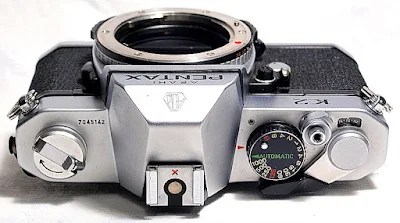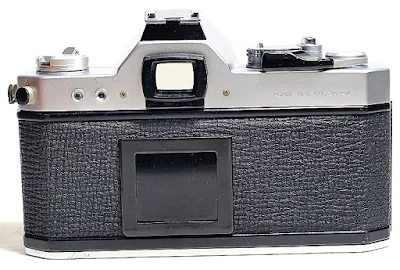Introduced by Pentax in 1975, the K2 was the flagship camera of a trio of 35mm SLR cameras, which included the KX and KM. The camera system was fitted with the new K-lens mount system, which was developed for a joint venture project with Zeiss, which, sadly, did not materialize.
By itself, the K2 is an aperture-priority automatic exposure SLR camera, selected when the shutter speed dial is set to 'Automatic'. The camera will automatically select the proper shutter speed between 1/1000 and 8 seconds when the shutter release is activated.
The K2 also features a depth of field preview, mirror lockup, and mechanical shutter at speeds from 1/125 to 1/1000 second and 'B'.
The Pentax K-series cameras were the first product range to take over from the M42 mount of the Spotmatic series, and though they were just as big and bulky, they were more refined and elegant in design and construction. The series was complemented with the K1000 in 1976, which is a stripped-down version that came without the self-timer.
Pentax K2 35mm SLR film cameras are available in black-and-silver and all-black versions. A special version of the K2, the K2 DMD, was introduced in 1976 that could use a data back and motor drive (hence "DMD"), together with other enhancements that were aimed at the professional market.
The K-series cameras, however, enjoyed only a short production run, as the system was replaced by the compact M-series with the introduction of the Pentax ME in 1976.
Basic Camera Features
Mechanically, the K2 comes fitted with a vertical run metal focal-plane shutter with both step-less electronically controlled and manual speed range from 8 to 1/1000 second, 1/125 second for flash sync., and B. Shutter speeds between 1/125 to 1/1000 second can also be used when the battery is dead. Film ISO speed range is 8-6400, and Exposure Compensation is at 4X, 2X, 1X, 1/2X, and 1/4X.
The camera is also fitted with mirror lockup, DoF (Depth of Field) preview, and a 5 to 9-second delay self-timer activated by the shutter release button. The K2 is powered by a pair of LR/SR44 button cells.
A simple and uncluttered front, with the make and model on the chrome top, DoF (depth of field) preview button, and self-timer lever towards the shutter side top of the front plate. The mirror lock-up lever and lens release button are on the upper-right and lower-left of the lens mount upright. Complementing the lens mount are the film ASA and exposure compensation rings located at the front of the lens mount itself.
The top plate is a straightforward arrangement of the film rewind crank and pull-up film back latch release on the left end of the plate, the pentaprism hump fitted with a hot shoe slightly left from the center of the camera body, and the shutter speed dial, lockable shutter release button, film forward crank, and frame counter window grouped to the right.
On the back of the top plate are the pair of fp- and X-flash terminal sockets right on the left shoulder of the camera top, the battery check button and battery lamp next to it, and the viewfinder eyepiece at the back of the pentaprism hump. The rest of the back, to the right of the top plate, is plain. A film tab memo holder is located on the film back.
On the bottom plate, the film rewind release button, the tripod socket, and the battery chamber cover.
The film box is a standard configuration as seen on most SLR film cameras of that era, with the film canister chamber on the left end of the camera body, followed by the shutter window, sprocket gear, and multi-slot take-up spool on the opposite end of the film box.
Film Loading and Rewinding
Film loading on the Pentax Super Program is the standard manual procedure of opening the film back, placing the film canister into the canister chamber, pulling the film tab across the film box, and inserting the film tab end into one of the slots of the multi-slot take-up spool, and tensioning it towards the inner side of the take-up spool. The film is wound emulsion side up.
Once the film back is closed, do the two blank shots sequence to bring the unexposed part of the film properly to Frame 1 before commencing with exposed shots for the rest of the film roll.
To rewind, press the film rewind release button located on the bottom plane of the camera, and turn the film rewind crank in the clockwise direction until the film is completely rewound before taking the film canister out and sending it for processing.
Viewfinder Readout
The K2 is fitted with a prism finder with a non-interchangeable cross-micro prism or split-image focusing screen with a 95% field of view, and a shutter-speed display vertical bar with a green shutter speed pointer and match needle exposure pointer.
In Automatic mode, the green shutter speed bar is at rest at the top of the vertical, and in manual shooting mode, the bar reflects the shutter speed setting of the shutter speed dial. The match needle pointer indicates the exposure value to which the shutter speed is matched. Metering is activated when the shutter button is half-pressed.
Setting Film ISO Speed and Exposure Compensation
One minor irk that I have with the K2, which I have yet to master, is the sequence of setting the film ISO speed and exposure compensation, which is not particularly convenient.
To set film ISO speed, first, depress the black lock button located on the lower right (5 o'clock) of the lens mount housing, and rotate the ASA scale ring to match the speed to the small red triangle located on the ring above it. The black lock button can only be depressed when the exposure compensation value is set to 1X.
To set the exposure compensation value, grasp the two black knurled tabs low on either side of the lens mount and rotate firmly to bring the desired multiplying factor on the black ring opposite the tiny red index dot (half-hidden and almost impossible to see) at ten o’clock on the lens mount. Make sure the ASA setting has not been offset during the process.
One observation seen often in forums on the camera is a sticky or stuck film ISO ring, which has, over the years, collected a fair bit of dirt and gunk that may render it immobile. One simple cure to this situation is to have the ring serviced and re-lubed, which can actually be a DIY project or a minor CLA.
Battery and Camera Body Weight
The camera requires a pair of LR/SR44 button cells to operate, and its body weight is 680 grams without batteries.
Instruction Manual
The instruction manual for the Pentax K2 is available from buktus.org (donations accepted), and you may download the instruction manual from this link.
In Use
The Pentax K2 is definitely one of the better cameras from the list that I tested recently. Solid and sure, the camera has a very well-damped reflex return, giving way to hardly any vibration at all, and a metering system that is very quick and responsive to boot. Another delight on the unit I tested was the super-smooth film-forward action, something not always seen in 40-year-old film cameras.
One giveaway is, of course, the weight of the camera, which, when compared to current compact DSLRs, is comparatively heavy at around the 950-gram mark when mounted with an SMC Takumar 50mm F1.4, and the sticky film ISO ring, which may have to be cleaned of dust and gunk it has collected over the years.
Other than these spots of giveaways, the solidly built Pentax K2 is definitely a camera to own, use, and enjoy photography with. Highly recommended!
























No comments:
Post a Comment